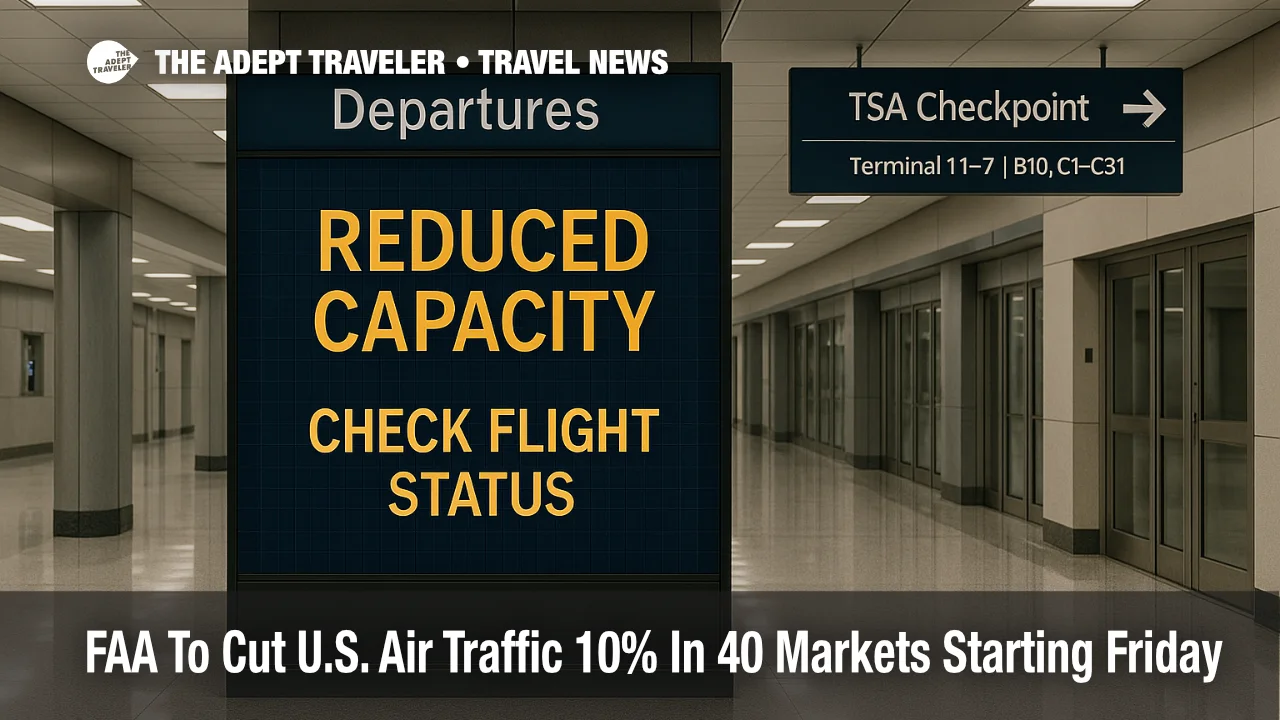FAA To Cut U.S. Air Traffic 10% In 40 Markets Starting Friday

Key points
- FAA will trim air traffic by 10% across 40 high-volume U.S. markets starting Friday, November 7, 2025
- Move aims to manage controller fatigue during a government shutdown that began October 1
- List of affected airports will be released Thursday and could shift as staffing fluctuates
- Airlines are assessing schedules with customer notifications expected as plans finalize
- Weekend staffing alerts have tripled versus pre-shutdown baselines according to operations plans
Impact
- Expect Longer Connection Buffers
- Build 60-90 minutes into domestic connections at large hubs until the FAA lifts the cap
- Watch For Schedule Changes
- Enable airline app alerts and recheck itineraries 24 hours and 4 hours before departure
- Consider Alternate Airports And Times
- Earlier departures and secondary airports may face fewer metering delays
- Check Rebooking And Waivers
- Airlines may issue options for same-day changes without fees at impacted stations
- Arrive Earlier For Departures
- Reach the airport at least 2 hours before domestic flights and 3 hours before international
The Federal Aviation Administration said it will reduce air traffic by 10 percent across 40 high-volume U.S. markets beginning Friday, November 7, 2025. Officials framed the cap as a safety measure as air traffic controllers continue working unpaid during the government shutdown that started October 1, with many staffing six-day weeks and mandatory overtime. Airlines are evaluating schedule adjustments now; the FAA plans to publish the list of affected airports on Thursday. Travelers should expect added metering, longer taxi queues, and more missed connections unless they build extra time into their plans.
What changed and why it matters
FAA Administrator Bryan Bedford said rising fatigue indicators and staffing pressures across towers, approach facilities, and en-route centers justified a proactive reduction rather than waiting for a crisis. The 10 percent cap will temper the number of takeoffs and landings airlines can operate in the busiest markets, spreading demand across the day and reducing controller workload on each shift. Transportation Secretary Sean Duffy underscored that the system remains safe, however, the constraints will persist as long as necessary while staffing remains strained during the shutdown.
Latest developments
The FAA and airline operations teams began coordinating on Wednesday to translate the national cap into local rate limits, sometimes called "airport acceptance rates" and "en-route metering." Southwest said it is evaluating potential schedule impacts and will contact customers as plans firm up. A formal airport list is due Thursday; until then, assume major hubs and their feeder flows will bear the brunt of the cap.
Where delays are most likely
Historically, reductions of this type concentrate at airports where a few facilities handle a large share of traffic, for example Chicago, Atlanta, New York, Los Angeles, Dallas, Denver, and San Francisco. When one hub is throttled, the effect cascades into inbound and outbound banks across the network. Over the past five weekends, the average number of FAA facilities flagging potential staffing shortages has tripled compared with pre-shutdown weekends, a sign of broader strain beyond any single city. Travelers with tight connections through the largest hubs should add 60 to 90 minutes, or rebook to longer layovers.
How it works (background)
Air traffic control, ATC, regulates flows into the airspace and into each airport's runway configuration. When staffing is thin, the FAA can lower the planned arrival and departure rates so controllers manage fewer aircraft simultaneously. Airlines then reduce published schedules or hold flights on the ground, creating rolling delays rather than pushing the system toward unsafe loads. In practical terms, passengers will see more ground holds before takeoff, longer lines for pushback, and missed connections if buffers are short.
What airlines and airports are saying
Carriers are preparing customer notifications and contingency schedules. Early statements from airline and airport spokespeople suggest a focus on preserving first-wave departures in the morning, then smoothing midday peaks where controller staffing is tight. Local media reports indicate some airports, including in the Bay Area and Boston, are awaiting FAA specifics before issuing guidance, which is typical when national flow programs are still being tuned. Expect additional advisories after the FAA posts the airport list.
Planning tips for the next 7 days
If you are booked through a large hub between Friday and early next week, check your airline app today and enable push alerts. Re-shop alternatives that depart earlier in the day, since morning flights are less exposed to rolling downstream delays. If you are on separate tickets, pad your layover by at least two hours. For essential trips, consider a nonstop or a secondary hub with historically lower holding times. If airlines publish change-fee waivers for your origin or destination, act quickly, since same-day inventory on favorable flights will disappear first.
Final thoughts
The FAA's 10 percent reduction is a safety-first step to manage controller fatigue during a prolonged shutdown. Until staffing stabilizes, travelers should expect additional metering and longer connection times at the busiest airports. The primary keyword is FAA reduces air traffic, and the near-term reality is that measured capacity today is better than disruption tomorrow.
Sources
- FAA reducing air traffic by 10% across 40 'high-volume' markets during government shutdown
- FAA says it will cut thousands of flights a day starting Friday due to shutdown
- FAA Press Releases
- Senate confirms new FAA administrator at a time of rising concern about air safety
- New FAA administrator says state of US air traffic unacceptable, morale low at agency
- FAA cuts flights by 10%: What Bay Area airports are saying
- FAA reducing air traffic by 10% across 'high-volume' markets
